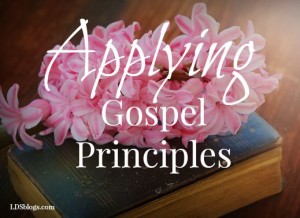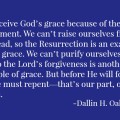During construction of the Lubbock Texas Temple, the building coordinator told us stories about building details I’d never even considered. He asked if we’d ever signed our names on a concrete floor before it was covered in carpet or on studs before hanging sheetrock. Most of us had some that or something similar.
He said that even though a contract to not add graffiti to any part of the temple is signed by construction workers sometimes the workers will still leave graffiti. Any graffiti has to be removed before beginning the next building phase.
Once, someone spray-painted profane words on a section of the Lubbock Temple’s foundation. During his inspection, the building coordinator spotted the graffiti as it was about to be covered by the next stage of construction. He stopped work immediately and required the graffiti to be completely removed before proceeding further.
Workers had to sandblast the words off of the concrete. It was time-consuming and delayed forward progress. After all trace of the profanity was removed, construction continued.
Learning to Repent
That story about the foundations of the temple being squeaky clean, without spot or blemish, really impacted me. I knew I had some spots and blemishes—whether self-imposed or splashed on my foundation by others—that needed to be sandblasted away.
But how?
As a child, I learned to repent by recognizing I’d done something wrong, asking forgiveness, and not doing it again. In some cases, I’d stopped doing whatever it was, but I hadn’t really taken it to the Lord and asked for His forgiveness and cleansing love. As I started approaching Him, I felt invisible weights lifting off my heart.
Taking Full Advantage of the Redeeming Power of Repentance
Richard G. Scott described how to repent.
To read more of Delisa’s articles, click here.
Are you taking full advantage of the redeeming power of repentance in your life so that you can have greater peace and joy? Feelings of turmoil and despondency often signal a need for repentance. Also the lack of the spiritual direction you seek in your life could result from broken laws. If needed, full repentance will put your life together. It will solve all of the complex spiritual pains that come from transgression. But in this life it cannot remedy some of the physical consequences that can occur from serious sin. Be wise and consistently live well within the boundaries of righteousness defined by the Lord.
There are several vital steps to repentance. Each is essential for complete forgiveness. President Joseph F. Smith identified some of these steps this way: “True repentance is not only sorrow for sins, and humble penitence and contrition before God, but it involves the necessity of turning away from them, a discontinuance of all evil practices … a thorough reformation of life, a vital change from evil to good … to make restitution, so far as … possible, for all the wrongs we have done. … This is true repentance, and the exercise of the will and all the powers of [the] body and mind is demanded, to complete this glorious work of repentance.”
To the vital steps of recognition, sorrow, abandonment, confession, and restitution where possible, it is also essential to add the requirement to diligently keep all of the commandments of God. …
Formulas have been crafted to help remember some of the essential actions required for full repentance. While these can be helpful, generally they ignore the most fundamental aspect of repentance—that it is centered in Jesus Christ and in His Atonement, that it has efficacy because He willingly paid the full price through His redeeming sacrifice, motivated by a perfect love of His Father and of each of us. …
I testify that Jesus Christ paid the price and will satisfy the demands of justice for all who are obedient to His teachings. Thus, full forgiveness is granted, and the distressing effects of sin need no longer persist in one’s life. Indeed, they cannot persist if one truly understands the meaning of Christ’s Atonement.
To repent means to turn from sin and turn to Christ. He can remove the graffiti on our soul! And while we may feel like we’re sandblasting ourselves during the process, to stand clean and spotless before God, graffiti-free, is an incomparable gift the Savior gives to us.
About Delisa Hargrove
I am a member of The Church of Jesus Christ of Latter-day Saints. I have moved 64 times and have not tired of experiencing this beautiful earth! I love the people, languages, histories/anthropologies, & especially religious cultures of the world. My life long passion is the study & searching out of religious symbolism, specifically related to ancient & modern temples. My husband Anthony and I love our bulldog Stig, adventures, traveling, movies, motorcycling, and time with friends and family.








Love that analogy of sandblasting our sin away through repentance. The visual is real. It takes real intent, real desire to change.
It was so visual for me too. I’m glad you could see it too.